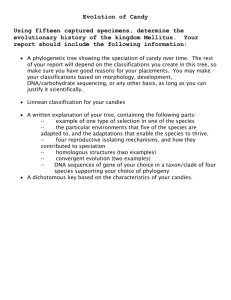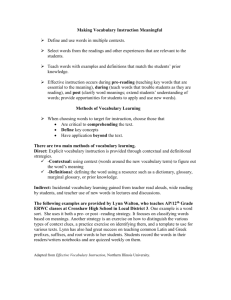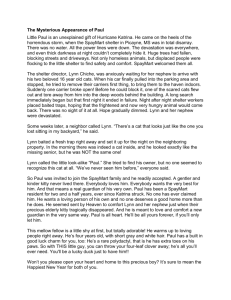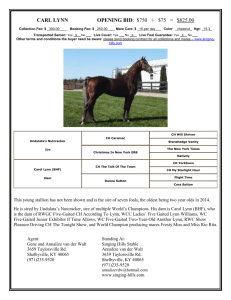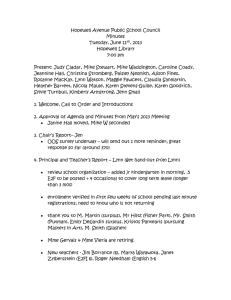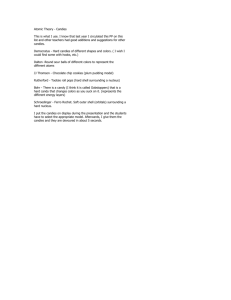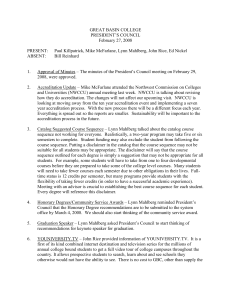Learning the Language of Elementary Arithmetic
advertisement
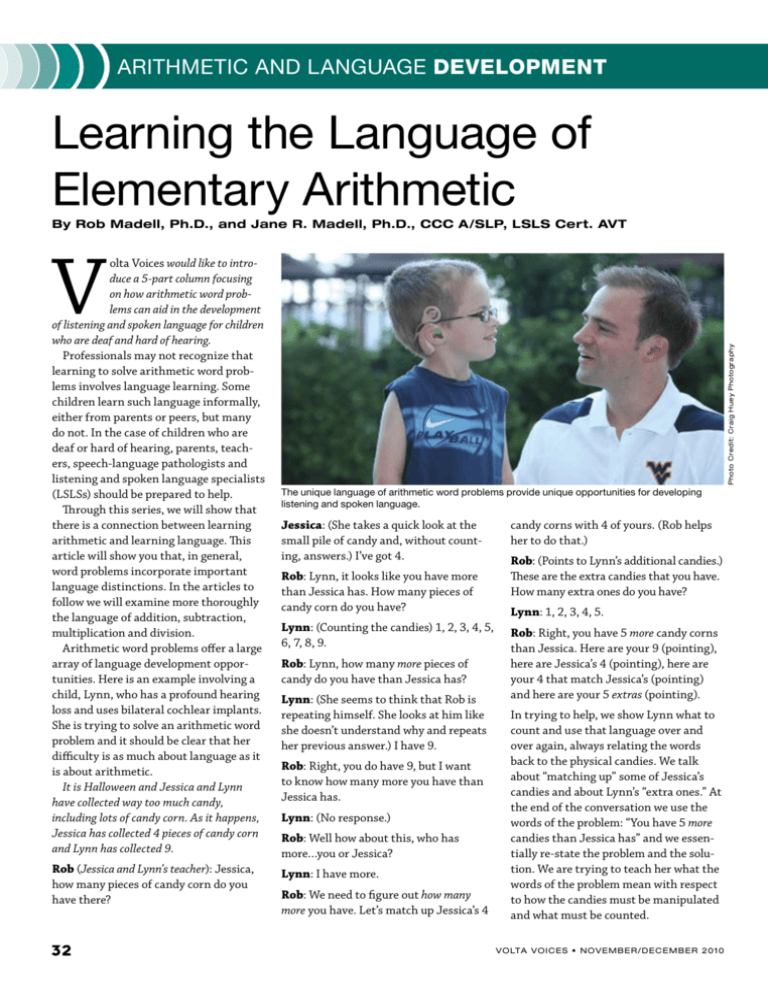
Arithmetic and Language Development Learning the Language of Elementary Arithmetic By Rob Madell, Ph.D., and Jane R. Madell, Ph.D., CCC A/SLP, LSLS Cert. AVT Rob (Jessica and Lynn’s teacher): Jessica, how many pieces of candy corn do you have there? 32 Photo Credit: Craig Huey Photography V olta Voices would like to introduce a 5-part column focusing on how arithmetic word problems can aid in the development of listening and spoken language for children who are deaf and hard of hearing. Professionals may not recognize that learning to solve arithmetic word problems involves language learning. Some children learn such language informally, either from parents or peers, but many do not. In the case of children who are deaf or hard of hearing, parents, teachers, speech-language pathologists and listening and spoken language specialists (LSLSs) should be prepared to help. Through this series, we will show that there is a connection between learning arithmetic and learning language. This article will show you that, in general, word problems incorporate important language distinctions. In the articles to follow we will examine more thoroughly the language of addition, subtraction, multiplication and division. Arithmetic word problems offer a large array of language development opportunities. Here is an example involving a child, Lynn, who has a profound hearing loss and uses bilateral cochlear implants. She is trying to solve an arithmetic word problem and it should be clear that her difficulty is as much about language as it is about arithmetic. It is Halloween and Jessica and Lynn have collected way too much candy, including lots of candy corn. As it happens, Jessica has collected 4 pieces of candy corn and Lynn has collected 9. The unique language of arithmetic word problems provide unique opportunities for developing listening and spoken language. Jessica: (She takes a quick look at the small pile of candy and, without counting, answers.) I’ve got 4. Rob: Lynn, it looks like you have more than Jessica has. How many pieces of candy corn do you have? Lynn: (Counting the candies) 1, 2, 3, 4, 5, 6, 7, 8, 9. Rob: Lynn, how many more pieces of candy do you have than Jessica has? Lynn: (She seems to think that Rob is repeating himself. She looks at him like she doesn’t understand why and repeats her previous answer.) I have 9. Rob: Right, you do have 9, but I want to know how many more you have than Jessica has. Lynn: (No response.) Rob: Well how about this, who has more…you or Jessica? Lynn: I have more. Rob: We need to figure out how many more you have. Let’s match up Jessica’s 4 candy corns with 4 of yours. (Rob helps her to do that.) Rob: (Points to Lynn’s additional candies.) These are the extra candies that you have. How many extra ones do you have? Lynn: 1, 2, 3, 4, 5. Rob: Right, you have 5 more candy corns than Jessica. Here are your 9 (pointing), here are Jessica’s 4 (pointing), here are your 4 that match Jessica’s (pointing) and here are your 5 extras (pointing). In trying to help, we show Lynn what to count and use that language over and over again, always relating the words back to the physical candies. We talk about “matching up” some of Jessica’s candies and about Lynn’s “extra ones.” At the end of the conversation we use the words of the problem: “You have 5 more candies than Jessica has” and we essentially re-state the problem and the solution. We are trying to teach her what the words of the problem mean with respect to how the candies must be manipulated and what must be counted. VOLTA VOICES • NOVEM BER/ DECE M BER 201 0 Here is an example involving a multiplication word problem. The child, Mike, has a moderately severe hearing loss and uses bilateral hearing aids. In this case, it is not that Mike does not understand. Rather, he has misunderstood. Once again his difficulty is as much about language as it is about arithmetic. Jane (Mike’s teacher): I have a very hard problem for you to try to solve. Suppose that your dog, Punch, has 3 collars. Mike: She only has 2. Jane: OK. But just suppose that she had 3 collars. And suppose also that she had 4 scarves. Mike: (He has been building with some wooden blocks and picks out 3 blocks to represent the collars and, in a separate pile, 4 blocks to represent the scarves. Without even knowing what the question is, Mike knows that it will be helpful to make a physical model of it.) Jane: OK. Good. Now when Punch gets dressed up for something special, she likes to wear a scarf and a collar. So here is what I want to know. How many outfits does Punch have? So if she wants to wear a scarf with a collar, how many different outfits can she make? Mike: (Matching 1 “collar” with 1 “scarf”), here is 1 outfit. Jane: OK. Mike: (Matching a second “collar” with a second “scarf,” and then the third “collar” with a third “scarf.”) She can make 3 outfits. Mike: (He pauses and then looks at the fourth scarf.) But what should I do with this? (essentially 9 2 4 5 ), we used the actual candies that the words of the problem referred to. In Mike’s outfit problem (essentially 3 3 4 5 ), he represented his understanding of the problem with the blocks that he happened to be building with. 2. For each word problem, the physical model that represents the problem can be manipulated so that together with appropriate counting, the problem can be solved. Mathematics educators agree that before children start to memorize “facts,” such as 9 2 4 5 5 and 3 3 4 5 12), they should first learn to solve word problems by making physical models of them and counting. 3. If you pay careful attention to the actual words of mathematical word problems, you see that problems, which may seem similar, require distinct models, manipulation and counting. As a consequence there are more types of word problems than you might think. For example, we could have asked Lynn the following: You have 9 candy corns. Suppose that you gave 4 of them to Jessica. How many would you have left? Like Lynn’s original problem, this one can also be represented by 9 2 4 5 . But the words describe an entirely different situation. The two problems require very different models. And here is a problem that, like Mike’s, can also be represented by 3 4 5 . But it is much easier to model. There are 3 shelves of books in your room. There are 4 books on each shelf. How many books do you have altogether? Mathematics educators disagree about the number of different word problem models. But by our count and for the purposes of this series, there are two addition models, three subtraction models, three multiplication models and two division models. Some children learn how to model some word problems without direct, explicit instruction. But very few children (with or without typical hearing) learn to model them all in this way. Parents, teachers, speech-language pathologists and LSLSs should make themselves familiar with all the different models. They should systematically introduce lots of different word problems and help children understand the language of those problems so that they can model and solve them as well as develop better listening and spoken language skills. In the articles to follow we will examine addition problems, subtraction problems, multiplication problems and division problems. Altogether, 10 different word problem models will be discussed. Collectively the articles present all of the word problem models that children are likely to see in school and will provide suggestions for helping children with hearing loss develop the language of arithmetic. Editor’s Note: Also available in Spanish at www.t-oigo.com / También disponible en español en la página web, www.t-oigo.com. Mike’s misunderstanding is not unreasonable. Punch can in fact only assemble 3 outfits at any one time. Although the words of the problem don’t make it explicitly clear, the intent is to ask for all possible combinations. You might want to think about how to help Mike represent those combinations so that he can count them. Examples like these illustrate three things about elementary arithmetic: 1. Every word problem can be represented by a physical model of the problem. In Lynn’s candy problem VOLTA VOICES • NOVE MBER/DECE MBER 201 0 33
